the 2007 Abstract Presentations - Wound Healing Society
the 2007 Abstract Presentations - Wound Healing Society
the 2007 Abstract Presentations - Wound Healing Society
You also want an ePaper? Increase the reach of your titles
YUMPU automatically turns print PDFs into web optimized ePapers that Google loves.
<strong>Abstract</strong>s<br />
64<br />
TGF-BETA1-STIMULATED PAI-1 GENE EXPRESSION AND<br />
KERATINOCYTE MIGRATION REQUIRES COOPERATIVE<br />
TGF-BETA1/EGFR SIGNALING<br />
Paul J. Higgins<br />
Albany Medical College<br />
Expression of plasminogen activator inhibitor type-1 (PAI-1), a serine protease<br />
inhibitor important in <strong>the</strong> control of pericellular proteolysis and cell migration<br />
is spatially-temporally regulated following epi<strong>the</strong>lial wounding in vitro as well<br />
as in vivo. PAI-1 transcription is induced early after scrape injury to epidermal<br />
keratinocyte monolayers and restricted to <strong>the</strong> motile cohort closely recapitulating<br />
<strong>the</strong> cell-type specificity of PAI-1 gene expression during cutaneous healing.<br />
Use of a PAI-1 promoter-driven luciferase reporter and direct imaging of a<br />
PAI-1 promoter-GFP construct in wound-juxtaposed cells confirmed <strong>the</strong><br />
location-specificity of gene regulation in this model. The role of PAI-1 in<br />
wound repair was assessed using keratinocytes isolated from PAI-1 / mice<br />
and siRNA approaches. PAI-1 / epidermal cells had a prominent migratory<br />
deficit. Motile responses equivalent to wild-type keratinocytes could be ‘‘rescued’’<br />
by addition of exogenous PAI-1. PAI-1 knockdown with siRNA<br />
inhibited injury site closure following scrape trauma but stimulated keratinocyte<br />
proliferation suggesting that PAI-1 reciprocally-regulated <strong>the</strong>se two basic<br />
aspects of injury repair. PAI-1 expression and motility were significantly<br />
increased in response to TGF-b1 but TGF-b1 failed to stimulate migration in<br />
PAI-1 / keratinocytes. Since PAI-1 is a prominent TGF-b1 target gene, and<br />
PAI-1 appears to be a major mediator of TGF-b1-mediated keratinocyte<br />
motility, it was important to assess <strong>the</strong> mechanism of TGF-b1-induced<br />
migratory activity. ERK activation, PAI-1 expression and wound-induced<br />
motility were all stimulated by addition of TGF-b1. Addition of AG1478, an<br />
inhibitor of EGF receptor signaling, effectively blocked all three responses and<br />
completely suppressed EGFR activation by TGF-b1. EGFR / cells did not<br />
express PAI-1 following TGF-b1 addition although cells engineered to reexpress<br />
<strong>the</strong> EGFR syn<strong>the</strong>sized both basal and TGF-b1-induced PAI-1. It<br />
appears that <strong>the</strong> coordinate programs of TGF-b1-stimulated PAI-1 transcription<br />
and keratinocyte migration utilizes cooperative TGFbR/EGFR signaling<br />
and activation of both receptor systems is required for efficient wound repair.<br />
Supported by NIH grant GM57242.<br />
65<br />
IMPLEMENTATION OF AN ELECTRONIC MEDICAL RECORD<br />
IN A WOUND CARE AND HYPERBARIC MEDICINE CENTER<br />
Bettina Magliato RN, MS, CIC, CWCN, CHRN<br />
Hartford Hospital Center for <strong>Wound</strong> <strong>Healing</strong> and Hyperbaric Medicine<br />
TUESDAY, MAY 1, <strong>2007</strong><br />
Angiogenesis<br />
Session Number: 51<br />
Tuesday, May 1, <strong>2007</strong>, 7:30 to 9:30 am<br />
<strong>Abstract</strong>s 66–74<br />
66<br />
EXPRESSION PROFILING REVEALS TARGETS OF CARDIAC<br />
ANKYRIN REPEAT PROTEIN (CARP) IN VASCULAR<br />
ENDOTHELIAL CELLS<br />
S.E. Samaras 2,3 , R.C. Bruntz 3 , C. Usoh 1 , and J.M. Davidson 2,3<br />
1 University of Tennessee, Knoxville, TN,<br />
2 Medical Research Service, Veterans Affairs TVHS, and<br />
3 Department of Pathology, Vanderbilt University School of Medicine<br />
Increased expression of cardiac ankyrin repeat protein (CARP) is seen in<br />
multiple cell types in murine skin following excisional wounding. We have<br />
observed that adenovirus-mediated CARP overexpression in <strong>the</strong> wound results<br />
in increased vascular density, suggestive of a specific activity in vascular<br />
endo<strong>the</strong>lial and smooth muscle cells. In vitro assays using <strong>the</strong> endo<strong>the</strong>lial cell<br />
lines HMEC-1 and MS-1 indicate that CARP exerts its effects by increasing cell<br />
survival, migration and morphogenesis. To identify direct and indirect targets,<br />
we infected HMEC-1 cells with adenovirus-CARP-IRES-GFP or adenovirus-<br />
Luc-IRES-GFP (control) for 24 h and 48 h. Microarray analysis was done on<br />
30 K gene arrays printed from <strong>the</strong> Compugen Human release 2.0 oligo library.<br />
Each treatment and hybridization was performed in triplicate. Analysis of <strong>the</strong><br />
data used a t-test with <strong>the</strong> Benjamini-Hochberg correction. Significant changes<br />
(p-value of 0.05, fold change Z1.5) occurred in several hundred genes. We<br />
focused our initial analysis on candidates that were closely related to wound<br />
healing and neovascularization processes. Provisional targets include 2 genes<br />
involved in TGF-ß signaling (TGFBR2, decreased; SMAD7, increased) and <strong>the</strong><br />
TNF-a receptor (decreased). The pattern of expression was consistent with a<br />
potential negative feedback loop following cytokine stimulation. Interestingly,<br />
ALK-1, an activin A receptor also involved in endo<strong>the</strong>lial TGF-ß signaling was<br />
increased, while ROBO4, a putative endo<strong>the</strong>lial receptor for Slit morphogens<br />
that is negatively impacted by ALK-1, was decreased. Consistent with <strong>the</strong> in<br />
vitro effects of CARP on endo<strong>the</strong>lial morphogenesis, we found increased<br />
expression of a gene for a protein implicated in endo<strong>the</strong>lial cell morphogenesis,<br />
CMG-1. Validation of <strong>the</strong>se targets and o<strong>the</strong>rs, as well as ongoing studies in<br />
smooth muscle cells, will provide efficient methods for determining <strong>the</strong> action<br />
and role of CARP in wound neovascularization. Supported by <strong>the</strong> Department<br />
of Veterans Affairs and <strong>the</strong> NIDDK.<br />
Problem: Tracking outcomes and creating meaningful reports is an elusive,<br />
time-consuming and inaccurate process when done by hand.<br />
Background: A high volume, high acuity wound care and hyperbaric medicine<br />
center handles approximately 10,000 patient visits per year. Hospital administration,<br />
insurance carriers, and physician offices request various reports and<br />
documentation on a monthly basis. The manpower and time spent collecting,<br />
reviewing and presenting <strong>the</strong> data in a sporadic fashion consumes <strong>the</strong> equivalent<br />
of almost two full time equivalent positions.<br />
Action: We believe that an electronic medical record is imperative for <strong>the</strong><br />
accurate, timely and cost-efficient management of <strong>the</strong> care being provided in a<br />
large wound care center. A complete needs analysis of <strong>the</strong> wound and<br />
hyperbaric center was performed to ensure that this EMR could meet our<br />
needs. By <strong>the</strong> end of <strong>the</strong> second year, a product was chosen and installed on sitein<br />
<strong>the</strong> hyperbaric medicine division first, followed shortly <strong>the</strong>reafter by <strong>the</strong><br />
wound center.<br />
Outcomes: The EMR has been in place now for twelve months in HBO and six<br />
months in <strong>the</strong> wound center. In HBO, <strong>the</strong> impact was apparent immediately.<br />
Treatment notes were completed and signed by <strong>the</strong> physician and nursing staff<br />
with 97% accuracy. Documentation requests from Medicare and o<strong>the</strong>r insurance<br />
carriers are easily addressed. There is no need to retrieve records from an<br />
off-site storage company. JCAHO and UHMS standards are incorporated into<br />
<strong>the</strong> EMR to ensure compliance. Overall, staff and administrative acceptance of<br />
<strong>the</strong> electronic medical record has been positive. Managing documentation and<br />
files has been streamlined. The medical director and administration can be<br />
provided with outcome and financial reports in a timely manner.<br />
<strong>Wound</strong> Rep Reg (<strong>2007</strong>) 15 A14–A54 c <strong>2007</strong> by <strong>the</strong> <strong>Wound</strong> <strong>Healing</strong> <strong>Society</strong><br />
A31




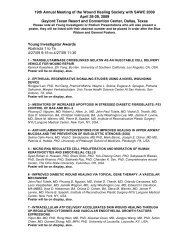

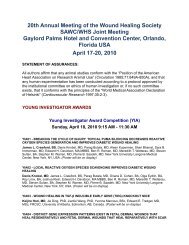
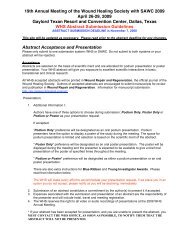
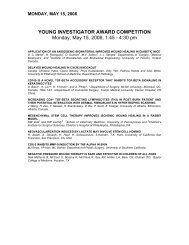

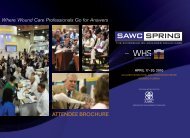

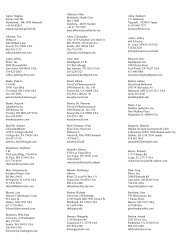
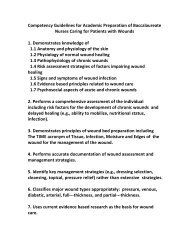
![2010 Abstracts-pah[2] - Wound Healing Society](https://img.yumpu.com/3748463/1/190x245/2010-abstracts-pah2-wound-healing-society.jpg?quality=85)